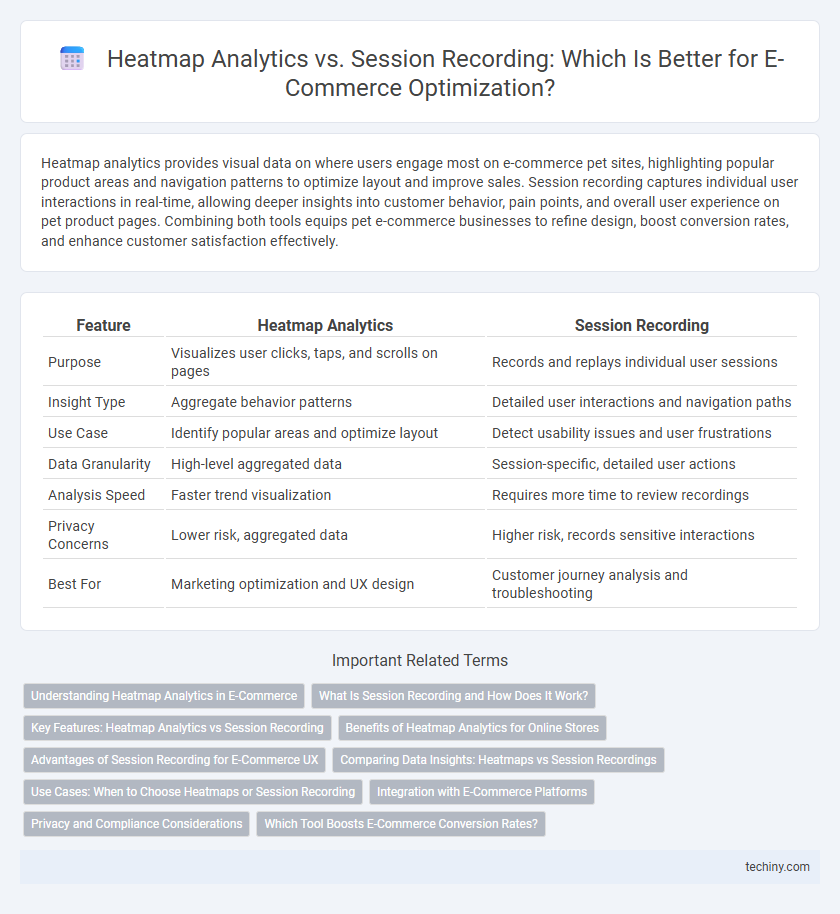Heatmap analytics provides visual data on where users engage most on e-commerce pet sites, highlighting popular product areas and navigation patterns to optimize layout and improve sales. Session recording captures individual user interactions in real-time, allowing deeper insights into customer behavior, pain points, and overall user experience on pet product pages. Combining both tools equips pet e-commerce businesses to refine design, boost conversion rates, and enhance customer satisfaction effectively.
Table of Comparison
| Feature | Heatmap Analytics | Session Recording |
|---|---|---|
| Purpose | Visualizes user clicks, taps, and scrolls on pages | Records and replays individual user sessions |
| Insight Type | Aggregate behavior patterns | Detailed user interactions and navigation paths |
| Use Case | Identify popular areas and optimize layout | Detect usability issues and user frustrations |
| Data Granularity | High-level aggregated data | Session-specific, detailed user actions |
| Analysis Speed | Faster trend visualization | Requires more time to review recordings |
| Privacy Concerns | Lower risk, aggregated data | Higher risk, records sensitive interactions |
| Best For | Marketing optimization and UX design | Customer journey analysis and troubleshooting |
Understanding Heatmap Analytics in E-Commerce
Heatmap analytics in e-commerce visually represent user interactions such as clicks, taps, and scrolls, highlighting the most engaging areas of a webpage. By identifying high-activity zones, businesses can optimize product placements, improve call-to-action visibility, and enhance overall user experience. Unlike session recordings, heatmap analytics provide aggregated data that quickly reveals behavioral trends without reviewing individual user sessions.
What Is Session Recording and How Does It Work?
Session recording captures and replays individual user interactions on an e-commerce site, allowing businesses to observe clicks, scrolls, mouse movements, and navigation paths in real time or post-visit. This technology provides granular insights into customer behavior, revealing usability issues, drop-off points, and engagement patterns without relying on aggregated data. By analyzing session replays, e-commerce platforms can optimize user experience, improve conversion rates, and tailor site design to meet shopper needs effectively.
Key Features: Heatmap Analytics vs Session Recording
Heatmap analytics provides visual representations of user interactions, highlighting areas with the most clicks, taps, or scrolling behavior to analyze engagement patterns on e-commerce websites. Session recording captures complete user sessions, allowing e-commerce businesses to observe navigation paths, mouse movements, and form interactions in real-time for in-depth behavioral insights. Combining heatmap analytics and session recording offers a comprehensive understanding of user experience, improving conversion rates and optimizing site design.
Benefits of Heatmap Analytics for Online Stores
Heatmap analytics provides e-commerce stores with visual data on user interactions such as clicks, scrolls, and mouse movements, enabling precise identification of high-engagement areas on product pages and call-to-action buttons. This method enhances conversion rate optimization by highlighting which elements draw attention and which are overlooked, facilitating targeted design improvements. Integrating heatmap analytics helps improve user experience and increase sales by making data-driven decisions based on real shopper behavior patterns.
Advantages of Session Recording for E-Commerce UX
Session recording provides e-commerce businesses with granular insights into customer behavior by capturing real-time interactions, including mouse movements, clicks, and navigation paths. This detailed playback helps identify specific usability issues and friction points that heatmap analytics might overlook, enabling targeted UX improvements. Enhanced understanding of user journeys through session recordings drives higher conversion rates and reduces cart abandonment in online stores.
Comparing Data Insights: Heatmaps vs Session Recordings
Heatmap analytics visualize aggregate user behavior by highlighting clicks, scrolls, and attention areas on web pages, enabling quick identification of popular elements and navigation patterns. Session recordings capture individual user interactions in real-time, providing detailed insights into mouse movements, keystrokes, and engagement paths critical for diagnosing usability issues and understanding user intent. Combining heatmaps and session recordings offers comprehensive data insights, balancing macro-level behavior trends with micro-level user experiences to optimize e-commerce website performance.
Use Cases: When to Choose Heatmaps or Session Recording
Heatmap analytics excels in identifying user interaction patterns on key pages by visually highlighting areas with the most clicks, scrolls, and attention, making it ideal for optimizing landing pages and product listings. Session recording captures real-time user behavior and navigation paths, providing detailed insights into user frustrations, drop-off points, and usability issues, which suits in-depth troubleshooting and UX improvements. Choose heatmaps for high-level engagement trends and session recordings for granular, qualitative analysis of individual user experiences.
Integration with E-Commerce Platforms
Heatmap analytics seamlessly integrates with major e-commerce platforms like Shopify, WooCommerce, and Magento, providing visual insights into customer interactions on product pages and checkout flows. Session recording tools complement this by capturing real-time user behavior, enabling detailed playback of browsing sessions to identify pain points and optimize conversion rates. Together, these solutions enhance e-commerce performance by combining quantitative data from heatmaps with qualitative analysis from session recordings.
Privacy and Compliance Considerations
Heatmap analytics aggregate user interaction data without capturing individual identities, reducing privacy risks and simplifying compliance with GDPR and CCPA regulations. Session recording collects detailed user behaviors, including keystrokes and mouse movements, which may capture sensitive information requiring strict consent management and data anonymization. E-commerce platforms must balance insightful user experience analysis with robust privacy policies to ensure regulatory adherence and build consumer trust.
Which Tool Boosts E-Commerce Conversion Rates?
Heatmap analytics visually represent user interaction patterns on e-commerce websites, highlighting areas that receive the most attention, clicks, and scrolls to optimize design and layout. Session recording captures detailed user behavior by replaying individual browsing sessions, revealing friction points and navigation issues in real-time. Combining heatmap analytics with session recordings provides comprehensive insights that significantly boost e-commerce conversion rates by improving user experience and increasing customer engagement.
Heatmap Analytics vs Session Recording Infographic

 techiny.com
techiny.com